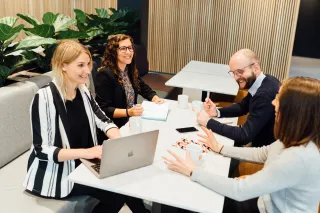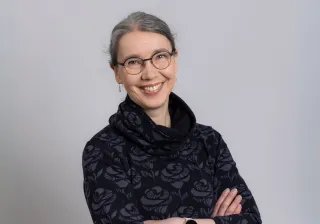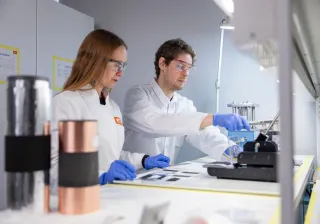Pekka Soini, who left Nokia to lead Tekes in September 2012, signals a new beginning. Tekes has become Business Finland and Finpro, and includes the organisations Visit in Finland and Invest in Finland.
Pekka Soini introduces the new organisation concisely as 'an internationalisation channel for companies'.
Business Finland (BF) is a unique model in the world. Nowhere else has a business internationalisation concept been combined with an organisation that also attracts investment and tourists to a country.
Soini emphasises the word 'internationalisation' when referring to the new Business Finland. Business Finland uses international competition and global economic indicators in its evaluation processes. Finland must be able to rival its peer countries and use these as criteria for the development of new products and services.
– In Business Finland, we are not combining different organisations, but mixing the deck. All management posts must be reapplied for. That is why the reorganisation is taking time, even if our operations still run seamlessly.
Business Finland's customer operations form two entities.
– One is focused on Growth Companies and the other on the development of ecosystems, says Soini.
Growth Companies is an activator of small and medium-sized industries and service companies, and a business sparring and funding agency which helps companies heading for the world markets.
The ecosystem side involves various thematic and programmebased activities. It uses R&D to further develop ideas and is creating a platform for new businesses.
– This enables us to leverage our resources, improve customer service and help companies into the international market, while attracting targeted investments, he says.
Consumer products
– Tourism, health, the bio and circular economy, cleantech and consumer business are areas in which we have tremendous potential.
– For example, Business Finland is involved in consumer products and the development of the related e-commerce programmes, because we are lagging behind our peer countries in such areas. We need to develop digital platforms to support international sales of our consumer products, and create more branded products.
Food products, with their winning features of purity and health, are one area in which Finland can win big. As an example, Soini mentions the processing of oats, blueberries and cloudberries.
– New opportunities can also be found in games and fashion, and the creative sectors where actors such as Aalto University have done a great job, he says.
Soini believes that Finland should benefit fully from its fastgrowing tourism industry in other respects, particularly Lapland's international appeal.
– By attracting investment and talent, for example. Especially when you consider that tourists are so effective at building Finland's image.
Visit Finland is trying to repeat Lapland's success with its new Lakeland Finland programme, branding Lakeland Finland an international tourist hub.
– Work is required, in order to benefit fully from the summer season in Lapland. Winter tourism is not enough. We need to get visitors to stay in Finland for longer, he says. The digitalisation of the tourism industry is in its infancy.
Part of Team Finland
Business Finland is part of the Team Finland network, which supports the export efforts of companies.
BF helps companies to internationalise, all the way to market entry. It works with other Team Finland partners, such as the Ministry for Foreign Affairs, the Federation of Finnish Enterprises, the Confederation of Finnish Industries and Chambers of Commerce.
– BF does not fund exports or sell export consultancy. Export funding is handled by Finnvera and other funding agencies, whereas export consultancy is a task for private companies, he says.
The Ministry for Foreign Affairs and BF's international network compile overviews of the opportunities in various markets. This 'Market opportunities' service is freely available online.
– We are going to add twenty or so to the 100 or so employees in Business Finland's international network, adds Soini.
According to Soini, this will not bloat the organisation, but reap the benefits of private networks while avoiding overlaps with organisations such as the Chamber of Commerce.
Money talks
During 2010–2014, Tekes was still receiving funding of around EUR 600 million per year, but this was cut dramatically thereafter. This left only half of the funds that had been available for grants in 2016. Including loans and grants, Tekes was left with around EUR 400 million per annum.
The cuts in Tekes' funding for the years 2015-2017 reduced research funding for universities and research institutes from around two hundred million to one hundred million euros.
A year ago, in February 2017, Soini requested a EUR 100 million increase in state funding to cover the loss. Tekes received a pledge of EUR 30 million in additional funding for both 2018 and 2019.
– The OECD report on Finland states that, without further funding, we are in danger of losing ground to our international competitors.
– Our ability to invest in areas such as artificial intelligence, the platform economy, and various pilot platforms has been weakened, he says.
Geography a challenge
Business subsidy amounts have been under discussion in Finland for years. Although Business Fin land plays no role in distributing many business subsidies, Soini has a view on the issue in general.
– In our sparsely populated country, one of the major subsidies consists of logistical support, particularly fuel subsidies, he says.
According to Soini, the competitive disadvantage due to geography could be eliminated by smart transport and automation of the transport chain. This would reduce the variable costs of transport, i.e. fuel and personnel costs.
– Our goal could be based on a vision of automated forest machines cutting timber in forests. They would move the timber to driverless lorries, which would take it to plants. From there, the products would be transported to ports by automated trucks, where automated cranes would load them automatically onto self-navigating ships, he says. According to Soini, new global export products could also be developed in Finland, based on the automation of the transport chain.
Fibre is one of our ace cards among biological products
Pia Qvintus presenting VTT's recycled fibre technology which has been used in evening dress is designed by Anna Ruohonen. The recycled fibre is processed into yarn and a knitting fabric that drapes nicely.
In Finland, major growth expectations have been set for fibre-based biotechnologies, due to the competitive advantage conferred by the long fibres in our wood raw material. Fibre-based bioproducts are the hard core of the bioeconomy. Text: Esko Lukkari Photo: Timo Porthan
Pia Qvintus (MSc. Eng.), who is leading the three-year 'Innovative Bioproducts' growth programme, explains that Finland is the world leader in fibre-based products and the related R&D.
Qvintus is employed by VTT but also serves as the leader of Business Finland's growth programme.
The programme is helping startups and SMEs in the bioeconomy sector to enter the markets, create international growth and develop business activities, as well as identify capital and international investors in the industry.
– Sweden is a close rival in terms of its fibre expertise. They have done a great deal of valuable nanocell research. One of their focus areas is biomass-based chemicals. Germany has focused on the manufacture of chemicals from biomass, he says.
Companies are internationalising
Bioproducts are under development by a number of actors in Finland. Major projects include the BF-funded 'Design Driven Value Chains in the World of Cellulose' (DWoC) programme. In this five-year programme worth over EUR 11 million, VTT, Aalto University, Tampere University of Technology and the University of Vaasa are developing new, designoriented cellulosic materials and applications.
Design-based biomaterial development has been applied in the Hiilinielu Design Studio (Carbon sinks) project led by Tampere University of Applied Sciences and the NoMa (Novel structural materials with multi-scale fibre components) project led by VTT and Lahti University of Applied Sciences.
Business Finland's BioNetsproject involved the creation of circular economy and bioeconomy ecosystems, with the goal of creating a roadmap for their internationalisation. Uusi puu (New wood) is a communications project involving over 20 organisations.
The Innovative Bioproducts growth programme is engaged in cooperation with the Packaging Valley and New Fibre Products ecosystems.
The target countries of the growth programme include Sweden, Denmark, Holland, Belgium, Germanspeaking Europe, Great Britain, Japan and Korea, and possibly the United States and Canada.
– We organise seminars, participate in trade fairs and assist in business and investor meetings. We also prepare customers for the international markets, says Qvintus.
Collaboration with Sweden
For example, KTH from Stockholm, Chalmers University from Gothenburg and RISE are engaged in intensive cooperation with VTT and various universities. Such cooperation will be boosted over the next few years by Sweden's gift to the 100-year-old Finland: The Tandem Forest Values project – the funding of twelve postdoctoral researchers engaged in forestry research and the development of new products.
Many domestic companies developing fibre-based bioproducts have only a million euros or so in turnover, but they are thought to have major market potential.
According to Qvintus, spinoffs from VTT such as Paptic, which manufactures materials to replace plastic bags; Infinited Fibre and Spinnova, which both make textile fibres are already entering industrial production.
Sulapac is already manufacturing bio-packaging for cosmetics while Welmu, which makes biodegradable food plastics; Wall +, which makes wall materials; Woodio, which makes washbasins; and Lumir, which makes acoustic solutions, are close to production.
The global forest giants have made good progress with bio-products. Metsä Board is launching ecobarrier packaging made of fibre board, Metsä Tissue is making Saga baking dishes, Stora Enso is manufacturing recyclable EcoFishBox fish packaging, Stora Enso/Pyroll Scanstar roe boxes and Walki Agripap mulching paper. Eagle Mills is making rapid progress with its recyclable and compostable ISLA disposable cups.
Wood has many applications
– Montisera is developing technologies for extracting spruce sugar from sawdust. Repolar is processing spruce sap into skin and wound care products. Naviter and Forest of Lapland are extracting cosmetic products from berries. Innomost is developing wood-based polymers to replace synthetic components in cosmetics, says Qvintus.
She is certain that new Finnish biomass-based products will appear in the coming years.
– This three-year programme began with startups and micro-enterprises. So patience is needed.
An aromatic compound, lignin, whose further processing is of interest to companies, can also be produced from wood. Possible lignin-based products include biochemicals, composites, traffic fuels, technical carbons, glues and carbon fibres. Lignin products are being developed by large companies in Finland.



